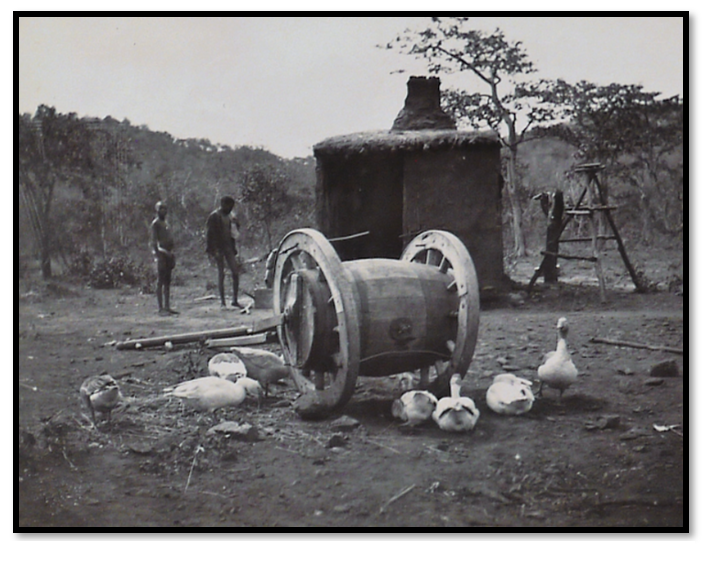The Price of Water
In the early days of mining in Rhodesia, money and water were always short...

In the early days of mining in Rhodesia, money and water were always short...
The Price of Water
Gold was found on the surface but water was first found in the Globe Mine at 180 feet. This was enough for the boilers but drinking water had to be hauled from the Rennie Tailyour Spruit that ran in the rainy season. When this ran dry in the winter, water had to be hauled by ox wagon in 400 gallon tanks from the Sebakwe River, 5 miles away. The Globe and Phoenix invested in hundreds of oxen at £18 per head. Smaller outfits found ingenious ways to transport water to satisfy their needs. It was always a precious commodity. Water was borrowed from one neighbor to another in much the same way that milk or sugar are today.
But the Rinderpest epidemic of 1896, followed by lung sickness reduced the Company's cattle to 2 cows, 1 bull and 3 oxen. November of 1898, the G & P obtained permission to pipe the water from the Sebakwe River. Below the mine compound, there were a huddle of 13 houses and 20 business stands, the nucleus of what would later become Que Que, to be supplied. The G & P also provided the Gaika and surrounding smallworkings with water.
As they say, 'when you fall into a Rhodesian river, you get up and dust yourself.' And so it was in 1904. Water was brought up by African labor those 180 feet from the Globe shaft. The water was then drawn from the company's central tap in 4 gallon paraffin tins.
People from the neighboring Gaika Mine had to walk two miles to get water from the G & P to fill up their tins. This increased the existing tension between the G & P and the Gaika Mines and threatened the security of the huddle of buildings below the G & P.
Soon the G & P employees were rationed too. A charge of 10 shillings/month was established. It was forbidden to supply outsiders with water. In the following year, with not a cumulous cloud in sight, water tickets were issued to all water users, including the G & P employees, and rationed to 10 gallons a day per household or 5 gallons per single person.
The Murray Mine just to the north of the G & P was rented– not for its gold--but for its water which was suitable for boilers. Two wells were sunk on the company's mining claims for domestic purposes.
Both Whitewashed Jacarandas and Full of Possibilities are available on Amazon as paperbacks and eBooks.
The historical novel Whitewashed Jacarandas and its sequel Full of Possibilities are both available on Amazon as paperbacks and eBooks.
These books are inspired by Diana's family's experiences in small town Southern Rhodesia after WWII.
The various town characters lay bare the racial arrogance of the times, paternalistic idealism, Zionist fervor and anti-Semitism, the proper place of a wife, modernization versus hard-won ways of doing things, and treatment of endemic disease versus investment in public health. It's a roller coaster read.
References:
- The Midlands Observer October 17, 1975 The Globe and Phoenix is 80 Years Old This Weekend.
- Olden Que Que, Reminiscences by Mrs. Maleham
- An Historical Account of the Globe and Phoenix Gold Mine. 1894-1935. Thesis Heather Heap, University of Rhodesia, 1971.
- Photo credit: https://zimfieldguide.com/midlands/british-south-africa-company-and-impact-early-gold-mining-regulations-smallworkers

